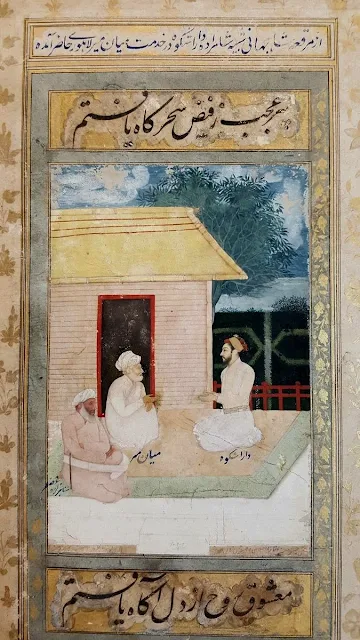A View of The Mosque of Wazir Ali Khan at Lahore by William Carpenter, 1856. Museum no. IS.57-1882
Lahore was the historic capital of the Punjab and one of the most important cities in the Mughal empire, founded in 1526. In the late 16th century, the great Mughal emperor Akbar had built a great fort there which was enlarged by his successors. The Mughals laid out gardens whose trees provided relief from the searing heat of summer, built palaces covered with polychrome tiles, and tombs decorated with marble inlaid with semi-precious stones.
Lahore was renowned for its carpets, the most luxurious examples woven from pashmina, the silken wool[
of the Himalayan goats that was also used to weave the Kashmir shawls worn at court. The city's many craftsmen included armourers, their weapons of watered steel delicately chiselled with arabesque patterns or inlaid with gold.
The emperors lived in Lahore for long periods, or stopped on their way from Delhi and Agra to the mountains and flower-filled valleys of Kashmir. The city attracted merchants, artists and scholars from all over the empire and beyond, including Europeans such as the Jesuit priests. Their gifts of western paintings and engravings profoundly influenced the developing style of Mughal painting in the late 16th and early 17th century.
Mughal power declined in the 18th century and the Sikhs eventually came to rule the Punjab, uniting behind Ranjit Singh who was proclaimed Maharaja in Lahore in 1801.
Some Famous Places Build by Mughals In Lahore.
Photograph of the Chauburji Gateway at Lahore, taken by an unknown photographer in the 1880s, part of the Bellew Collection of Architectural Views. The Gateway of the Four Minarets or Chauburji was once the entrance to one of Lahore’s many pleasure gardens.
The Tomb of Asif Khan is a mausoleum located in Shahdara Bagh in Lahore, Punjab. It was constructed for the Mughal statesman Abul-Hasan ibn Mirza Ghiyas Beg, who was titled Asif Khan.
Asif Khan was the brother of Empress Nur Jahan, and father of Arjumand Bano Begum, who became the consort of Shah Jahan under the name Mumtaz Mahal.
Rupee Coin Minted In Jahangir
An official audience held at the Mughal court at Lahore in 1649, featuring the Emperor receiving his son Aurangzeb, who is pictured with his arm raised in salute. c.1650-5
Jahangir was the 4th king of Mughal Era who ruled from the year 1605 A.D to 1627 A.D. Its tomb is situated in the great city of Lahore and it is a famous monument in Pakistan which was built by his son Shah Jahan. It got the place over the Rs. one thousand’s note of local currency. A famous Sha dara garden is located in the Lahore where you could find this tomb. Sha dara means the “gate of king”, or a gate which was used by the King. Char bagh is another garden of Mughal Empire.
Inside the tomb of a Mughal emperor JAHANGIR who ruled Indo-Pak subcontinent from the year 1605 - 1627. This tomb was built by Emperor Shahjahan, the son of Jahangir,
The Alamgiri Gate is the main entrance to the Lahore Fort built during the reign of Aurangzeb.
Dara Shikoh visiting the Sufi saints Mian Mir of Lahore and Mullah Shah of Badakhshan. The party is seated on a mat before a simple hut. In the background is a river and a tree. Signed at the bottom Chitarman.
Shalimar Gardens Lahore
Princess Nur Jahan Wife of Mughal Emperor Jahangir who was The Main Poweron whose Name The Coins were also Minted













No comments:
Post a Comment